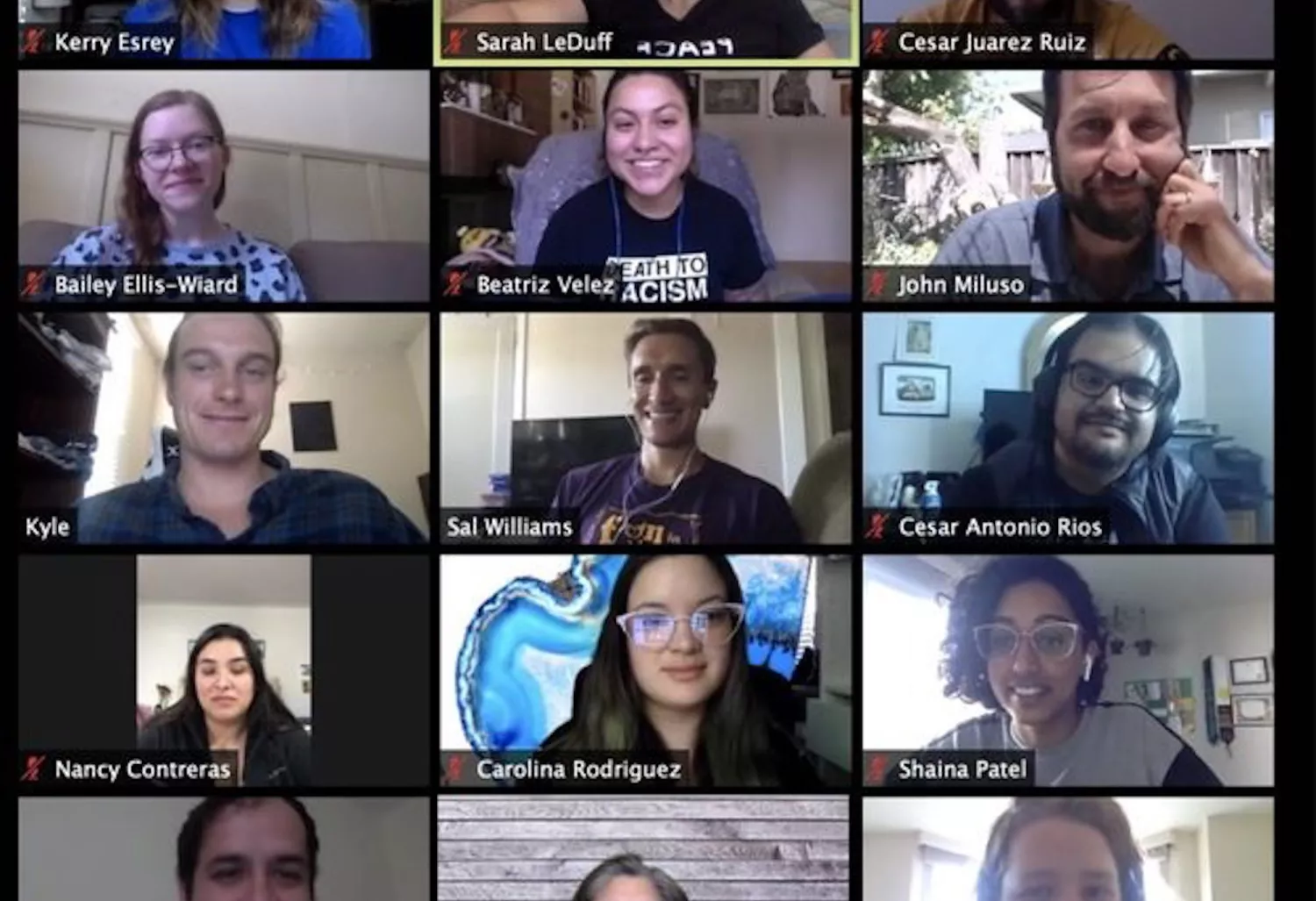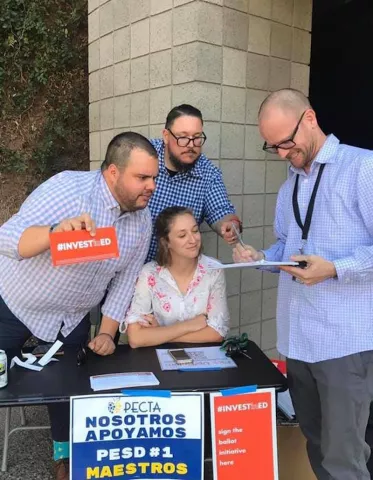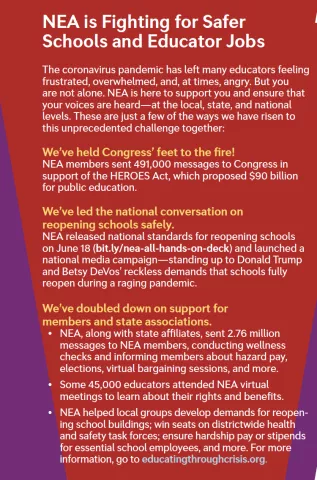This year turned out differently than anyone could have imagined: The coronavirus pandemic.
Economic downturn. Attacks on Black bodies. Attempts over the summer by President Donald Trump and Secretary of Education Betsy Devos to reopen schools with no national plan in place to do it safely nor any sign of the coronavirus slowing down. Plus, they threatened to pull federal funding if schools don’t open for in-person learning. It’s a lot to digest.
But one thing has remained a constant: Union members from coast to coast continue to fly the #RedForEd flag and are building strength in numbers—claiming victories along the way. From the major health care victory in New Jersey to the virtual birth of a local union in California to a steady stream of advocacy wins and skyrocketing membership for a small Phoenix local, educators are once again proving the power of their voice.
Solidarity in California
Solidarity is an unstoppable force, even in the middle of a pandemic. Case in point: A group of about 100 educators in San Jose, Calif., organized a new union amid shelter-in-place orders.
When teachers and counselors from four Downtown College Prep (DCP) charter schools filed for recognition on May 11, South Bay Educators United (SBEU) became the newest local of the California Teachers Association (CTA)—and likely the first educators union in the country organized during the COVID-19 pandemic. This effort is a testament to what educators will do to support each other, protect their students, and defend the school community they love.
In late-February, a small group of educators began organizing to advocate for their students and create positive change. Unsustainable expectations by management, a lack of support for educators, and a disconnect with realities facing students and staff fueled the group’s desire to organize a union.
Due to COVID-19 restrictions, the historic campaign occurred without any in-person organizing.
Alum Rock Middle School educator and SBEU member Carolina Rodriguez said the “distance organizing” was surprisingly streamlined and had many unexpected benefits.
“We were able to have one-to-one conversations without the tension of being on campus,” says Rodriguez, a 2009 graduate of DCP. “There was flexibility in response times for teachers to think about our petition and ask questions, and meetings could be held at any time that worked, because commuting and location were not an issue.” “I don’t think we would have been able to get a supermajority [of educators signing union cards] without the time and space to talk through things with people,” says Beatriz Velez, a history teacher at El Primero High School.

When SBEU organizers knew they had the support to file for union recognition, a new COVID-19-era challenge arose: collecting physical signatures on cards to submit to the state Public Employment Relations Board.
“We’d call and say, ‘We’ll be there in 15 minutes,’ and they’d come out and leave the signed card at a safe social distance,” Velez says. “It was like DoorDash for unions.”
In addition to being strong advocates for their students and families, SBEU members are eager to bring their perspective as charter school educators to discussions in CTA about how best to support and nurture all students.
“Knowing that there are people in your school, your district, and in schools around the state who have your back feels good,” Velez says.
Phoenix Union Builds Local Power
A few years ago, Arizona’s Phoenix Elementary Classroom Teachers Association (PECTA) was a small local with low membership numbers. The union had operated without a contract for years. After April 2018, however, when the state’s #RedForEd wave inspired educators to walk out of their classes in record numbers, it was game-on for a new crop of members who took a long, hard look at their union and saw potential.
“We saw the power of collectively working together and organizing—and what that power could create,” says Carlos “Chico” Robinson, a social studies teacher at Kenilworth Elementary School, who was recently elected vice president of PECTA.
Robinson was one of a handful of #RedForEd organizers who ran for union leadership positions and won. What these leaders created within three years is nothing short of remarkable: a local, driven by rank-and-file members, that has tripled its membership numbers and holds a long list of victories. PECTA won a salary increase over three years for all certified staff; placed a cap on class sizes; secured extra pay for teachers who cover classes when substitutes are not available; and stopped the district from shuttering three schools that were home to underserved populations, among other wins.

The local also has been on the front lines of the coronavirus pandemic and justice for Black lives. They persuaded the school district to commit to distance learning in the fall—long before other Arizona school districts made a decision. And the union pushed school board members to adopt a statement on justice for Black lives, using language the local union developed.
Additionally, PECTA’s new leadership adopted their first agreement and are now recognized as the official bargaining agent for Phoenix Elementary certified educators. According to the agreement, every committee created by the district must include a PECTA member who plays a role in decisionmaking. Plus, a union representative must be at the table when the district is making decisions about the coronavirus.
“This is how it should be,” says Jay Barbuto, a middle school language arts teacher at Thomas A. Edison Elementary School and the recently elected president of PECTA. He succeeds Leanne Abushar, who was instrumental in catapulting educator voices to the forefront of the decision-making process after the #RedForEd walkouts.
While their membership numbers tripled, the more impressive outcome was that educators immediately got involved, says Barbuto.
“Educators now see the value of the union upfront, and they want in,” he says, explaining that the new leadership team has built a democratic organization that embraces a bottom-up approach. “You think of an activist as someone lighting things on fire, yelling, or storming the governing board. For us, an activist means you’re super-passionate and involved in a topic,” Barbuto explains. “As a union, we’re giving [these activists] the space to lead.”
New Jersey Educators Win Big on Health Care
Two years after launching a member-led organizing effort, the New Jersey Education Association (NJEA) secured a major victory in the statehouse. Gov. Phil Murphy signed legislation that will save educators thousands of dollars a year.

Under the new law, educators will have the option to select new health care plans with lowered premiums and reduced overall costs. Additionally, by implementing these cost-saving measures, school districts and taxpayers can also expect reduced costs. The legislation will generate more than $1 billion in annual savings for property taxpayers and educators while preserving quality health care for teachers and other school employees.
NJEA and its members had demanded relief from a 2011 state law that required members to pay between 3 and 35 percent of health insurance premiums, depending on their salary and plan, which chipped away at educators’ paychecks every year.
And not one legislator opposed the NJEA-backed legislation. “When every Republican in the legislature and every Democrat in the legislature and the governor of the state agree with the state’s largest public employee union on health care reform that protects high-quality benefits and saves everyone money, that may just be the most surprising political story of the year,” said NJEA President Marie Blistan during the signing event. “But here we are, because that’s exactly what happened.”
She added, “This law is a win-win-win for NJEA members, our students, and New Jersey residents … . We found the common ground and created solutions that help everyone … . Our schools are stronger, our members are more secure, and our communities are in a better position as we face the serious challenges ahead.”


